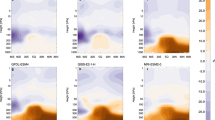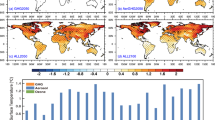Abstract
Ozone is an important air pollutant at the surface1, and the third most important anthropogenic greenhouse gas in the troposphere2. Since 1980, anthropogenic emissions of ozone precursors—methane, non-methane volatile organic compounds, carbon monoxide and nitrogen oxides (NOx)—have shifted from developed to developing regions. Emissions have thereby been redistributed equatorwards3,4,5,6, where they are expected to have a stronger effect on the tropospheric ozone burden due to greater convection, reaction rates and NOx sensitivity7,8,9,10,11. Here we use a global chemical transport model to simulate changes in tropospheric ozone concentrations from 1980 to 2010, and to separate the influences of changes in the spatial distribution of global anthropogenic emissions of short-lived pollutants, the magnitude of these emissions, and the global atmospheric methane concentration. We estimate that the increase in ozone burden due to the spatial distribution change slightly exceeds the combined influences of the increased emission magnitude and global methane. Emission increases in Southeast, East and South Asia may be most important for the ozone change, supported by an analysis of statistically significant increases in observed ozone above these regions. The spatial distribution of emissions dominates global tropospheric ozone, suggesting that the future ozone burden will be determined mainly by emissions from low latitudes.
This is a preview of subscription content, access via your institution
Access options
Subscribe to this journal
Receive 12 print issues and online access
$259.00 per year
only $21.58 per issue
Buy this article
- Purchase on Springer Link
- Instant access to full article PDF
Prices may be subject to local taxes which are calculated during checkout




Similar content being viewed by others
References
The Royal Society Ground-Level Ozone in the 21st Century: Future Trends, Impacts and Policy Implications (The Royal Society Science Policy, 2008).
Myhre, G. et al. in Climate Change 2013: The Physical Science Basis (eds Stocker, T. F. et al.) Ch. 8 (IPCC, Cambridge Univ. Press, 2013).
Richter, A., Burrows, J. P., Nüss, H., Granier, C. & Niemeier, U. Increase in tropospheric nitrogen dioxide over China observed from space. Nature 437, 129–132 (2005).
Duncan, B. N. et al. A space-based, high-resolution view of notable changes in urban NOx pollution around the world (2005–2014). J. Geophys. Res. 121, 976–996 (2016).
Lamarque, J. F. et al. Historical (1850–2000) gridded anthropogenic and biomass burning emissions of reactive gases and aerosols: methodology and application. Atmos. Chem. Phys. 10, 7017–7039 (2010).
Granier, C. et al. Evolution of anthropogenic and biomass burning emissions of air pollutants at global and regional scales during the 1980–2010 period. Climatic Change 109, 163–190 (2011).
Naik, V. et al. Net radiative forcing due to changes in regional emissions of tropospheric ozone precursors. J. Geophys. Res. 110, D24306 (2005).
Derwent, R. G. et al. Radiative forcing from surface NOx emissions: spatial and seasonal variations. Climatic Change 88, 385–401 (2008).
West, J. J., Naik, V., Horowitz, L. W. & Fiore, A. M. Effect of regional precursor emission controls on long-range ozone transport—Part 1: short-term changes in ozone air quality. Atmos. Chem. Phys. 9, 6077–6093 (2009).
Fry, M. M. et al. The influence of ozone precursor emissions from four world regions on tropospheric composition and radiative climate forcing. J. Geophys. Res. 117, D07306 (2012).
Gupta, M. L., Cicerone, R. J. & Elliott, S. Perturbation to global tropospheric oxidizing capacity due to latitudinal redistribution of surface sources of NOx, CH4 and CO. Geophys. Res. Lett. 25, 3931–3934 (1998).
Young, P. J. et al. Pre-industrial to end 21st century projections of tropospheric ozone from the Atmospheric Chemistry and Climate Model Intercomparison Project (ACCMIP). Atmos. Chem. Phys. 13, 2063–2090 (2013).
Hemispheric Transport of Air Pollution 2010—Part A Ozone and Particulate Matter (United Nations Economic Commission for Europe, 2010).
Cooper, O. R., Gao, R.-S., Tarasick, D., Leblanc, T. & Sweeney, C. Long-term ozone trends at rural ozone monitoring sites across the United States, 1990–2010. J. Geophys. Res. 117, D22307 (2012).
Cooper, O. R., Andrew, O., Parrish, D. D. & Fahey, D. W. Challenges of a lowered U.S. ozone standard. Science 348, 1096–1097 (2015).
Verstraeten, W. W. et al. Rapid increases in tropospheric ozone production and export from China. Nat. Geosci. 8, 690–695 (2015).
Riahi, K. et al. RCP 8.5-A scenario of comparatively high greenhouse gas emissions. Climatic Change 109, 33–57 (2011).
Lamarque, J.-F. et al. CAM-chem: description and evaluation of interactive atmospheric chemistry in the community Earth system model. Geosci. Model Dev. 5, 369–411 (2012).
Fiore, A. M., West, J. J., Horowitz, L. W., Naik, V. & Schwarzkopf, M. D. Characterizing the tropospheric ozone response to methane emission controls and the benefits to climate and air quality. J. Geophys. Res. 113, D08307 (2008).
Lawrence, M. G., von Kuhlmann, R., Salzmann, M. & Rasch, P. J. The balance of effects of deep convective mixing on tropospheric ozone. Geophys. Res. Lett. 30, 3–6 (2003).
Cooper, O. R. et al. Global distribution and trends of tropospheric ozone: an observation-based review. Elementa 2, 000029 (2014).
Petzold, A. et al. Global-scale atmosphere monitoring by in-service aircraft—current achievements and future prospects of the European Research Infrastructure IAGOS. Tellus B 67, 28452 (2015).
Thompson, A. M. et al. Southern Hemisphere Additional Ozonesondes (SHADOZ) 1998–2004 tropical ozone climatology: 3. Instrumentation, station-to-station variability, and evaluation with simulated flight profiles. J. Geophys. Res. 112, D03304 (2007).
Ding, A. J. et al. Tropospheric ozone climatology over Beijing: analysis of aircraft data from the MOZAIC program. Atmos. Chem. Phys. 8, 1–13 (2008).
Logan, J. A. An analysis of ozonesonde data for the troposphere: recommendations for testing 3-D models and development of a gridded climatology for tropospheric ozone. J. Geophys. Res. 104, 16115–16149 (1999).
Tilmes, S. et al. Technical note: ozonesonde climatology between 1995 and 2011: description, evaluation and applications. Atmos. Chem. Phys. 12, 7475–7497 (2012).
Ziemke, J. R. et al. A global climatology of tropospheric and stratospheric ozone derived from Aura OMI and MLS measurements. Atmos. Chem. Phys. 11, 9237–9251 (2011).
Parrish, D. et al. Lower tropospheric ozone at northern midlatitudes: changing seasonal cycle. Geophys. Res. Lett. 40, 1631–1636 (2013).
Parrish, D. D. et al. Long-term changes in lower tropospheric baseline ozone concentrations: comparing chemistry-climate models and observations at northern midlatitudes. J. Geophys. Res. 119, 719–5736 (2014).
Fry, M. M. et al. Net radiative forcing and air quality responses to regional CO emission reductions. Atmos. Chem. Phys. 13, 5381–5399 (2013).
Moss, R. H. et al. The next generation of scenarios for climate change research and assessment. Nature 463, 747–756 (2010).
Schopp, W., Klimont, Z., Suutari, R. & Cofala, J. Uncertainty analysis of emissions estimates in the RAINS integrated assessment model. Environ. Sci. Policy 8, 601–613 (2005).
Bond, T. C. et al. Historical emissions of black and organic carbon aerosol from energy-related combustion, 1850–2000. Glob. Biogeochem. Cycles 21, GB2018 (2007).
Smith, S. J. et al. Anthropogenic sulfur dioxide emissions: 1850–2005. Atmos. Chem. Phys. 11, 1101–1116 (2011).
Ohara, T. et al. An Asian emission inventory of anthropogenic emission sources for the period 1980–2020. Atmos. Chem. Phys. 7, 4419–4444 (2007).
Liousse, C., Essamoi, E., Criqui, P., Granier, C. & Rosset, R. Explosive growth in African combustion emissions from 2005 to 2030. Environ. Res. Lett. 9, 035003 (2014).
van der A, R. J. et al. Trends, seasonal variability and dominant NOx source derived from a ten year record of NO2 measured from space. J. Geophys. Res. 113, D04302 (2008).
Hilboll, A., Richter, A. & Burrows, J. P. Long-term changes of tropospheric NO2 over megacities derived from multiple satellite instruments. Atmos. Chem. Phys. 13, 4145–4169 (2013).
Thompson, A. M. et al. Tropospheric ozone increases over the southern Africa region: bellwether for rapid growth in Southern Hemisphere pollution? Atmos. Chem. Phys. 14, 9855–9869 (2014).
Tilmes, S. et al. Description and evaluation of tropospheric chemistry and aerosols in the Community Earth System Model (CESM1.2). Geosci. Model Dev. 8, 1395–1426 (2015).
Garcia, R. R., Marsh, D. R., Kinnison, D. E., Boville, B. A. & Sassi, F. Simulation of secular trends in the middle atmosphere, 1950–2003. J. Geophys. Res. 112, D09301 (2007).
Fry, M. M., Schwarzkopf, M. D., Adelman, Z. & West, J. J. Air quality and radiative forcing impacts of anthropogenic volatile organic compound emissions from ten world regions. Atmos. Chem. Phys. 14, 523–535 (2014).
West, J. J. et al. Co-benefits of global greenhouse gas mitigation for future air quality and human health. Nat. Clim. Change 3, 885–889 (2013).
Schultz, M. G. et al. REanalysis of the TROpospheric Chemical Composition over the Past 40 Years (RETRO)—A Long-term Global Modeling Study of Tropospheric Chemistry Final Report (Jülich/Hamburg, Germany, August 2007).
Guenther, A. B. et al. The model of emissions of gases and aerosols from nature version 2.1 (MEGAN2.1): an extended and updated framework for modeling biogenic emissions. Geosci. Model Dev. 5, 1471–1492 (2012).
Emmons, L. K. et al. Description and evaluation of the model for ozone and related chemical tracers, version 4 (MOZART-4). Geosci. Model Dev. 3, 43–67 (2010).
Prather, M. et al. in Climate Change 2013: The Physical Science Basis (eds Stocker, T. F. et al.) Annex II (IPCC, Cambridge Univ. Press, 2013).
Acknowledgements
Y.Z. and J.J.W. were funded by National Institute of Environmental Health Sciences grant no. 1 R21 ES022600-01 and Environmental Protection Agency STAR grants no. 834285 and RD83587801, and O.R.C. and A.G. were funded by NOAA’s Health of the Atmosphere and Atmospheric Chemistry and Climate Programs. The contents are solely the responsibility of the grantee and do not necessarily represent the official views of the US EPA or other funding sources. We thank the NCAR AMWG for developing and maintaining the diagnostic package for the model evaluation. We acknowledge the free use of O3 observation data from NOAA GMD for the remote sites of Barrow, Mauna Loa, Samoa and South Pole; Global Atmosphere Watch World Data Centre for Greenhouse Gases for Hohenpeissenberg, J. Schwab from University at Albany-SUNY for Whiteface Mountain, and P. Young of Lancaster University for processed ozonesonde climatology of ref. 25.
Author information
Authors and Affiliations
Contributions
Y.Z., J.J.W. and O.R.C. designed the study and Y.Z. and J.J.W. planned the model experiments. Y.Z. prepared the emission inputs, performed the model simulations, and prepared the figures. Y.Z. and A.G. conducted data analysis for observations, and J.J.W. and O.R.C. assisted with the data analysis. P.N., S.-Y.O. and A.M.T. provided observational data. Y.Z., J.J.W. and O.R.C. wrote the paper with comments from A.M.T and A.G.
Corresponding author
Ethics declarations
Competing interests
The authors declare no competing financial interests.
Supplementary information
Supplementary Information
Supplementary Information (PDF 8159 kb)
Rights and permissions
About this article
Cite this article
Zhang, Y., Cooper, O., Gaudel, A. et al. Tropospheric ozone change from 1980 to 2010 dominated by equatorward redistribution of emissions. Nature Geosci 9, 875–879 (2016). https://doi.org/10.1038/ngeo2827
Received:
Accepted:
Published:
Issue Date:
DOI: https://doi.org/10.1038/ngeo2827



